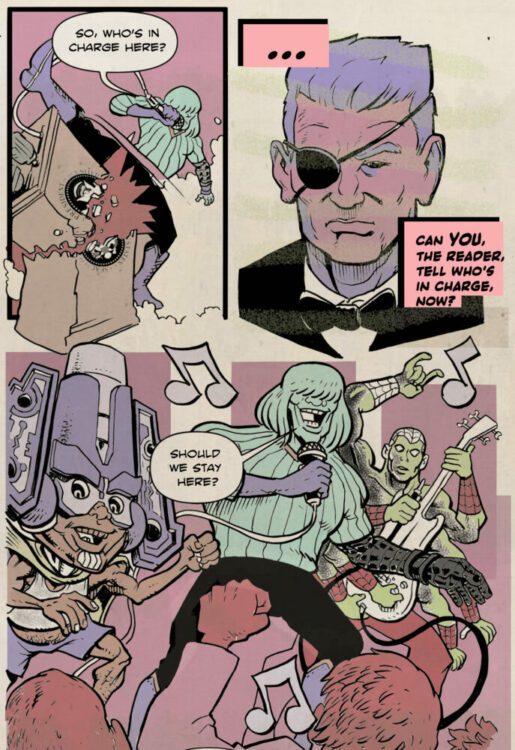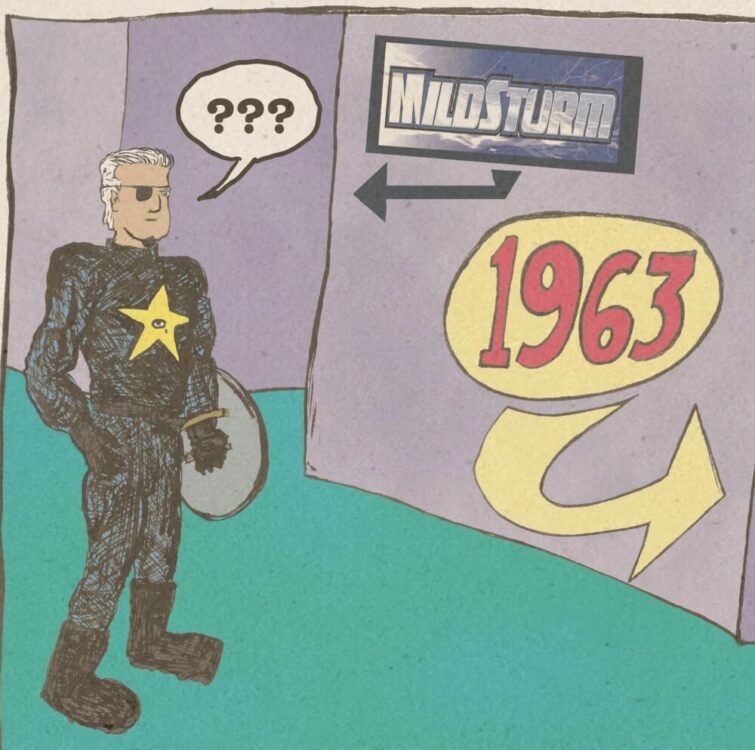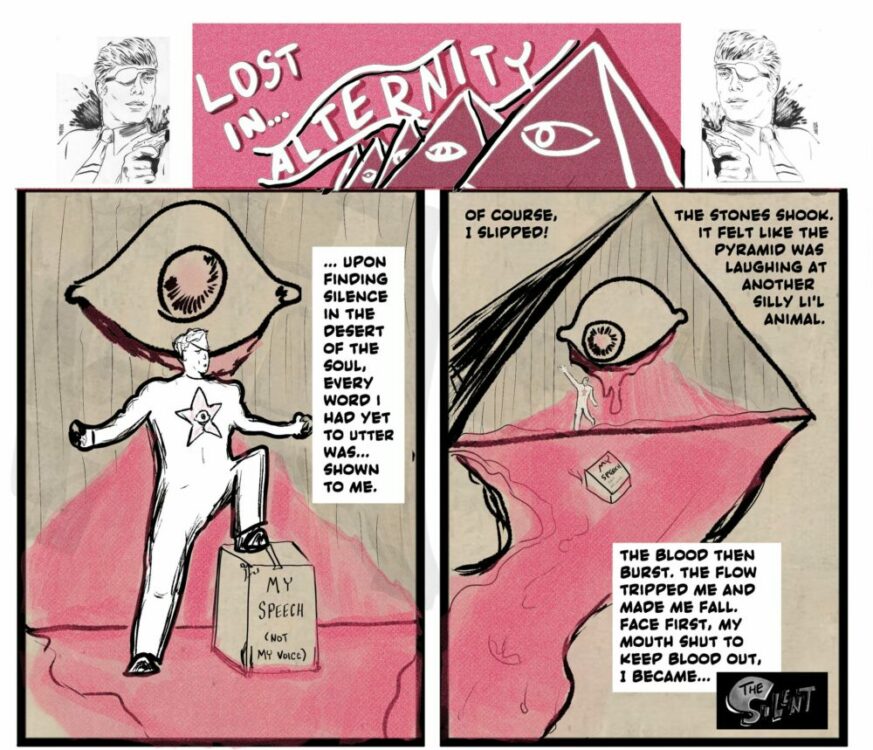Welcome to Self-Published Spotlight, a regular interview column where I will be highlighting self-published comics and the creators and small print publishers who make them.
Peter Hensel has worn many hats in the comics industry. Starting as a fan, he moved into becoming a successful retailer and, most recently has jumped into the creator pool with his book, Suspense Stories of The Silent. Peter’s passion for comics has always been evident in our conversations, so when he set on creating his own project, I knew I wanted to talk to him about it. I think you’ll find Peter (much like I do) to have a lot of insight into comics and what makes them so great. So check out our chat and then make sure to support the Kickstarter campaign, so we can all get this book in our hands!
Monkeys Fighting Robots: So Peter, what’s your comic book origin? How did you get into comics?
Peter Hensel: I always knew that the real world just wasn’t for me. Virtues like truth, and compassion for those weaker than me, these values always felt within me, and comics always taught and reflected the goodness I wished the real world held. For me I’ve always been into comics, in my earliest memories I was already a fan of Sonic (The Hedgehog) comics. I guess the deeper question would be how did I get into the real world because I’ve never felt not into comics. Growing up, I never really did have schoolyard friends. I played Magic: The Gathering, though, and pretty much grew up in comic and card stores. I volunteered for tournament help and got paid in store credit for comics, so as I was a teenager it just always felt like I had a stack of comics I was waiting to read, and going to the library, I found my comic reading never had to end if I had the will to make one trip to the library! Which I could bike to, so I really never did run out of comics to read. Still, have some. I got into drawing comics after I wrote several sci-fi novels and self-published them. I enjoy writing prose, I really do, but in my entire prose writing, I did feel like I was just compensating for not knowing how to draw things. And so, my first gig actually making comics was William Hoffknecht of 100% Comics offering me the chance to write my own 1963-universe licensed story! I learned how to color and letter after receiving the first pages, and have started to draw on my own, too. Although don’t worry, Suspense Stories of The Silent is only gonna have a couple of doodles from me! A whole bullpen worth of artistic talent is bringing my written vision to life. 
MFR ON YOUTUBE (latest video)
Help us reach 5K Subs!
MFR: You’re also a comics retailer, with your own shop. How did you end up running a comic shop? And did that affect the way you saw the medium?
PH: Well, the shop was born out of two moments. One was me genuinely wanting to support and influence the whole medium, not just as a customer deciding to purchase individual copies for myself, but as a store ordering multiple copies and supporting underground, less well-known titles. I want the shop to be a place where readers can discover things they’ve never encountered before. This was a fantasy I had for many years before actually opening up. The other motivating factor was, at one point in my early 20s, I had way too many back issue boxes. They started taking up the living room of a shared apartment instead of just my bedroom, so instead of having roommate issues, I did bring them to my first convention and then got a storage unit right after so my comics wouldn’t take up my whole life. The store came two years later when my Life Partner believed in me and a stable space enough to push me to lease my first very small month-to-month space in a San Antonio Mall. Through my time as a retailer, I’ve seen almost every type of comic either offered as a new one to order or in a box from someone trying to sell their collection to the store. All that time spent observing them, I kept imagining a comic that hasn’t looked like any comic I had seen before. Suspense Stories of the Silent #1 is that Eldritch comic from an unknown universe.
MFR: So what exactly is Suspense Stories of the Silent? Do you have a Hollywood-style “elevator pitch” for our readers?
PH: It’s the debut of a character with ages worth of history. Three different eras of stories relate to the raw golden age origin, the fun and vibrant swing of post comics code silver age, and his cyberpunk maturity in a technological mystery. All of the stories pay attention to what suspense they leave the reader in, and really focus on the idea that a story needs to have an element of mystery and intrigue resolved by a twist ending. EC Comics’ short stories are a major influence on how these suspense stories try to tell as much with as little as possible. The Silent part does not mean the comics themselves are without words, but that the hero never does speak up and say anything. The people start to call him The Silent because he never provides any words, except to his young fan Gerald who grows up to become his superheroic companion that we meet in “Planet of the Sapes”. Unlike older EC comics, there is a clear narrative connection between all the stories, and it is intended for fans of bizarre bronze age back issues and extra especially meant for the smart and thoughtful Detective-like reader who appreciates subtle fantasies and obvious enigmas.
MFR: So once the idea was born, how did you go about getting the project started? What would you say was your very first step? And did have an A to Z plan from the beginning?
PH: In a group meeting for 100% Comics Giant Sized ’63 Special, some of the characters didn’t have licensing rights, specifically the Ultimate Secret Agent, so calling upon the Jim Steranko Death of Captain America arc where publicly the American hero dies, the alter ego still lives on, shifting identities. Immediately, realizing that Ulysses Samson Armstrong’s voice would be instantly recognized from radio and newsreels, we decided to call him the Silent Minority. I went on to make the giant-sized 63 story with him and his falcon-like sidekick as minor cameos, but the idea of a hero who aged throughout the 40s through the comics code and beyond stayed with me. I made a comic special about my store Gotham Newsstand as a fictional 1946 store that the Silent M helped save from a violent body-doubling speculator-type character, and from there I knew he was gonna have a life of his own. Initially, I thought the second comic would come quickly, but I realized it would be best to work ahead as it has a pretty spicy cliffhanger, so I’m already more than halfway done with #2, and this Kickstarter is to raise funds to offset print this series on old newsprint styled pages, instead of keep it a smaller run modern digitally printed comic. So this Kickstarter is about making this an ongoing series instead of a three-issue mini-series, too, by raising a lot of interest which is even more important than the money were trying to raise in this campaign. To answer the second part, I’d say I planned the whole story together a year and a half ago, yea. Making the art and all the pages is taking a great amount of time focusing on each aspect of it. I didn’t quite plan to meet as excellent and eager an artist to make #3 happen, and the many plot and writing contributions from my artists have been incredible visions that became the future. 
MFR: What would you say is something new you learned about the medium by creating this comic? Like do you see it differently now?
PH: I had no idea of the tremendous amount of effort and revision that goes into every single page. On some of these pages, I dashed off a quick idea for a composition thinking about what issue #3 or #5 is gonna be like, but that random idea is so far away from now, considering the production time of the artists and the ability I have to raise or save personal money to pay them for their time… You really have to believe in the short little seven-page idea to see it through the many months from idea to the layouts to penciling to inking, then to lettering or coloring concerns. I learned to kind of sift ideas and leave some waiting, and to kind of reach for my own group of developed ideas when the time comes to go the studio with the artist and make what was loose and malleable into something molded and unchangeable. I initially learned how to color and letter my own pages to allow greater control and lower the costs of the project, but that has quickly become my own area of joy. Simply hand lettering some dialogue or finding the right way to shade colors on top of different colors, reproducing old school ben day dot coloring techniques with modern printing styles really has led me to see the old Copper and Bronze Age comics as something an intense amount of attention that many people gave. That sense of a letterer handling every page, then the colorist looking over everything too, really leads to more refined, elaborate pages, and I want to bring that sense of a whole group making a comic to these pages.
MFR: Let’s talk influences. Who are some of your favorite cartoonists? And since you found a love for lettering and coloring, do you have favorites in those as well?PH: Erik Larsen is my favorite cartoonist, of all time. Sometimes the stories are more about the set style, sometimes they’re talking heads exploration of a society with superheroes. They’re almost always funny, and each issue is a self-contained chunk of story that functions as its own moment and often reads differently in collected edition form. As an editor, Erik got lots of talent to tell his universe’s stories with the Image spinoffs Freak Force, Superpatriot, and Star, and in this first issue I function more as an editor overseeing his own creation than a full-on cartoonist. Although I did get nervous with this Kickstarter coming out and finished drawing a fourteen-page mini-comic story, I do want to cartoon, and visually I have tried drawing in the styles of Jaime Hernandez, butch guice, and Jack Davis to get a handle on anatomy, angles, and facial expressions before making my own pages. As a colorist, I learned a lot looking at the coloring of Cheis O’Halloran in Ice Cream Man. Using color shifts to convey the unreality of the Ice Cream Man encounters, or, sometimes, memories, delusions, temptations, and desires is all well done by establishing meaning behind background shifts and shifts in textures, among other decisions, too. You know, as a writer, W Maxwell Prince on Ice Cream Man and his other short works really inspired the emphasis on short forms, as well as Erik Larsen. The letterer I learned the most from is Tom Orzecowski and his amazing efforts in the Claremont X-Men at guiding your eye across the story with the design of lettering, sometimes foregoing captions and being able to capture different voices through different fonts and effects, too. For coloring though I spent a lot of time looking at a lot of older comics and how to emulate the Ben Day dot effects with many different layers of colored screen tone to achieve secondary colors and offset effects. Glynis Wein and Marie Severin are two of the best old-school colorists. They often color figures an unreal color, say orange when they erupt in anger, or maybe a chill. purple when they calm down. Or in memory sequences the backgrounds are red and all characters and foreground figures are light blue. They say a lot with simple color choices so the rest of the page’s elements can shine through.
MFR: Personally, I have loved seeing you grow as a creator. And it’s obvious you have a deep passion and understanding of the medium!
PH: Thanks for that, Manny. I started drawing in a Zoom ‘zine group across the screen from you and it means a lot you’ve seen the growth.


